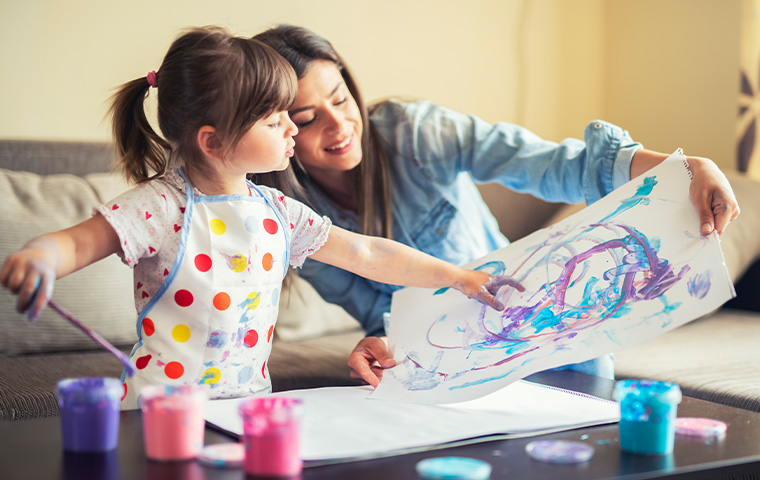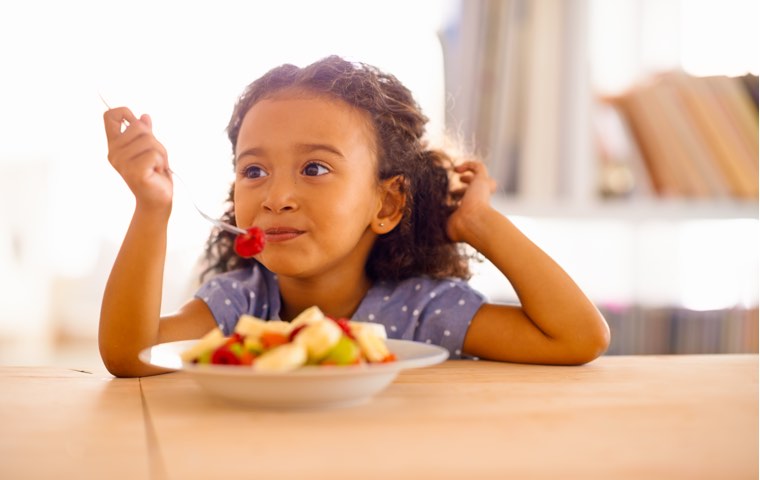Cooking as a Family Activity
When everyone’s busy with work and school, it can be hard to find time for family activities. But chances are good that you spend a lot of time in the kitchen fixing meals and snacks, so think about it as a good opportunity to bond. Having your kids help make family recipes and share stories can keep family traditions alive and create new ones. Don’t wait for special occasions to cook together—start now!
When kids help in the kitchen, they’re more likely to try and like a variety of foods.
Small Kids, Big Help
When it comes to cooking, kitchen safety is so important. Start by giving small children a safe place to be in the kitchen while you do the cooking. Let them know where their special spot is so they aren’t under your feet or in front of the stove. You might have them sit at the table, at the counter, or on the floor—somewhere they can bang on pots and pans, stack plastic bowls, or color paper placemats for family mealtimes. You can also let your kids help choose family recipes. They can smell, taste, and touch different foods and talk about their colors and flavors. They can also start helping with simple cooking tasks when you think they’re ready.
Let 4-year-olds:
- Turn a salad spinner.
- Tear lettuce and snap green beans.
- Cut soft foods with a dull plastic knife.
- Spread butter and jam.
- Peel oranges.
- Get out and put away kitchen tools and ingredients.
- Put spoons, forks, and plastic items in the dishwasher.
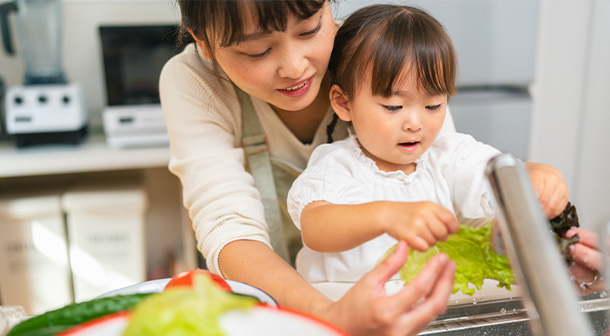
Let 5-year-olds:
- Roll out dough.
- Grease pans.
- Crack and beat eggs.
- Dip food in sauce or breadcrumbs.
- Measure dry ingredients.
- Wipe down the counter to make sure it is clean.
Let 6-year-olds:
- Help set and clear the table.
- Make balls or patties.
- Scoop batter into muffin cups.
- Dry dishes.
- Put dishes (except knives) in the dishwasher.
- Help put groceries away.
- Read recipes out loud.
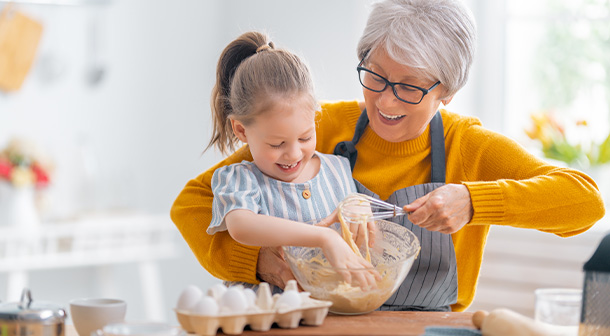
The kitchen is a place for gathering with family. It’s a place where memories are made and seasoned with love.
Kitchen Safety is Key
As children get older and learn basic kitchen safety skills, they can start to have more responsibility in the kitchen. From the time kids are small, be very clear that there are things in the kitchen that are NOT toys such as knives, the stove, and the oven. Every child is different, and only you will know when your child is ready to use these potentially dangerous kitchen tools. Some kids might not be ready for a long time! Take things slow and be sure to supervise.
Before you get started, make sure everyone washes their hands for at least 20 seconds and that countertops are clean. And never leave a child alone in the kitchen, especially if the stove or oven is on.
Knife Skills
- Start with softer foods, such as cheese or dough, that can be cut with a plastic knife or butter knife.
- When you’re teaching kids how to safely use a knife, tell them to go slow and be careful. You can place your hands over your child’s hands to help.
Using a Grater
- Show your child how to keep the grater steady with one hand and hold the end of the food they are grating. Guide their hands with yours.
- Watch out for little fingers. An adult should grate the last bit of carrot or cheese!
Cracking Eggs
- When kids are just learning, have them crack eggs into a separate bowl to make sure no bits of shell get in.
- Show your child how to tap the egg on the edge of the bowl to crack the shell, then gently pull it apart.
Peeling Vegetables
- Younger kids can peel things like oranges and onions by hand if you get the peel started.
- Older kids can use a vegetable peeler to peel carrots or potatoes.
- Show them how to hold the veggie at the top and peel downward to protect their fingers.
More Kitchen Safety Tips
- Don’t hold a child while you are at the stove, using a knife, or handling hot items.
- When you cook on the stove, turn the handles of pans away from you to prevent spills and burns.
- Stay close to the stove when you are cooking. It doesn’t take long for food to burn and even start a fire.
- Never set hot dishes close to the edge of a counter or table.
- Don’t leave towels and oven mitts lying near the stove top.
- Keep a first aid kit handy. Every cook gets minor cuts and burns from time to time.
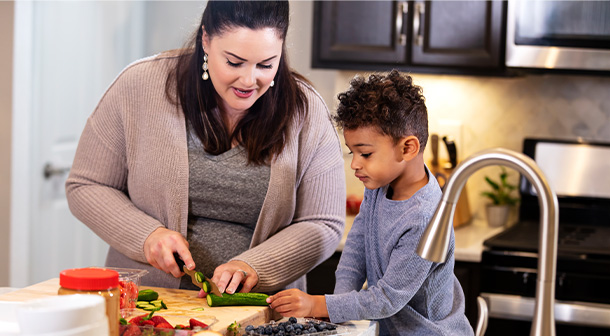
Plan for Family Together Time
Give your kids a special family activity time to look forward to each week. You might do Friday pizza night, Saturday lunch, or Sunday pancakes. Let your child help plan the menu for your special meal and talk together about what everyone in your family likes to eat. Make it a goal to follow the MyPlate guidelines, which recommend that half of the plate should be fruits and veggies.
If you need some kid-friendly family recipe inspiration, we’ve got some ideas:
- 4-Ingredient Banana Pancakes: You won’t believe that these tasty pancakes have no added sugar. Can you guess the four ingredients?
- Unicorn Smoothies: The recipe calls for bananas, berries, and mango, but you can use any fruit you have on hand.
- Funny Face: This delicious toast is a great way for kids and adults to be creative in the kitchen.
- Mexican Snack Pizza: Good for picky eaters! It’s easy to choose the toppings that each person likes.
Need parenting help now?
The Texas Parent Helpline is available 24/7.
- Call 833-680-0611
- Chat with us
- Text 833-680-0611
Let’s Get Cooking
Cooking as a family activity can be disorganized at times, but it’s worth it. By spending time in the kitchen together, you’re modeling lots of healthy habits. It’s a great way to get kids comfortable and confident in the kitchen, teach kitchen safety, and inspire a lifetime of healthy eating.
Cooking as a family activity needs to be fun. When kids are small, cooking together will probably be messy. Things might take longer. That’s okay! If things don’t always turn out perfectly, don’t worry. The key is to be patient and allow kids to be a part of the process. Teaching your child to make something will take more time than doing it yourself, so make sure you allow enough time to complete the recipe. Smiles and kind words of encouragement can go a long way in helping to build your children’s interest and confidence.
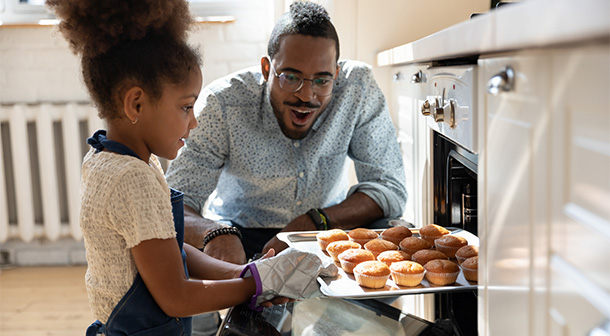
Kitchen as the Classroom
Cooking together can also be educational. Time in the kitchen gives you a chance to teach kids about healthy food choices and more, such as:
Colors, Shapes, and Sizes
Small children can learn colors, shapes, and sizes by choosing and comparing fruits and vegetables. Ask your child questions like, “Which is the biggest strawberry?” or “Which is the reddest?”
Letters
Have small children name the foods that start with different letters.
Math
When kids are small, they can help count ingredients and use measuring cups and spoons. As they get older, they can learn math skills and fractions by doubling or halving recipes.
Reading
Check out kids’ cookbooks from the library or cook foods that are mentioned in your child’s favorite books. After you make a recipe, you could even write a review or make notes about what you liked or didn’t like and what you would do differently next time.
Following Directions
Following a recipe step by step is a good way for children to practice doing things in order and reading directions before starting a task.
Science
Cooking is basically chemistry! Young children can learn that things like lemons and pickles taste sour because of acid. Older children can learn the science behind why food browns and bread rises.
Social Studies and History
Try foods from different countries, then find the countries on a map. Talk about how many cultures eat rice and try recipes that prepare it in different ways. Cook historic recipes and talk about the different foods that people ate long ago.
Problem Solving
What do you do when cookies get burned, you add too much salt to your soup, or you get halfway through a recipe and realize you’re missing a key ingredient? For older children, cooking is a good way to practice problem solving and critical thinking skills.

Food Is an Ingredient that Binds Families Together
Use the family activity of cooking as a time to get kids to share things about their day. Ask them to tell you what they like about being in the kitchen together or to share their favorite foods. With busy schedules, it isn’t always easy to find time to just visit with your kids. Kitchen time and mealtimes are both great ways to have that family together time.
Cleaning up can be an important part of the lesson, too! By watching how you do things in the kitchen, kids can learn to cook more efficiently and put things away as they go. If you don’t make a mess in the first place, you have less to clean up when you’re finished! Cooking together is also a good time to model a good balance of family responsibilities: If one person cooks dinner, someone else could do the dishes. Even by doing small tasks around the kitchen children can experience the pride of being a helpful, contributing member of the family.
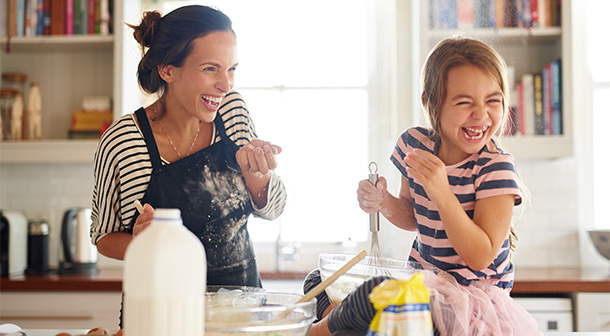
A Family Together in the Kitchen Makes a Difference
Being in the kitchen together has so many benefits. It’s a time to create new family activities, for kids to learn, for families to bond, and for everyone to build new memories. Research also shows that families who eat together are typically healthier and happier. So, make a plan that is right for your family. It could be cooking together on the weekends or setting a weeknight where kids get to help. The key is to commit kitchen time as family together time and enjoy the benefits that it can bring.


